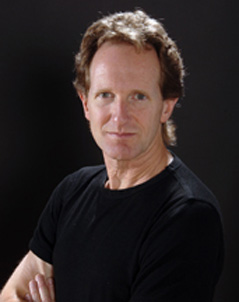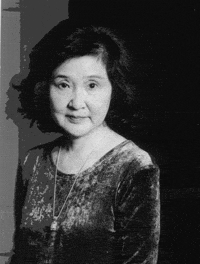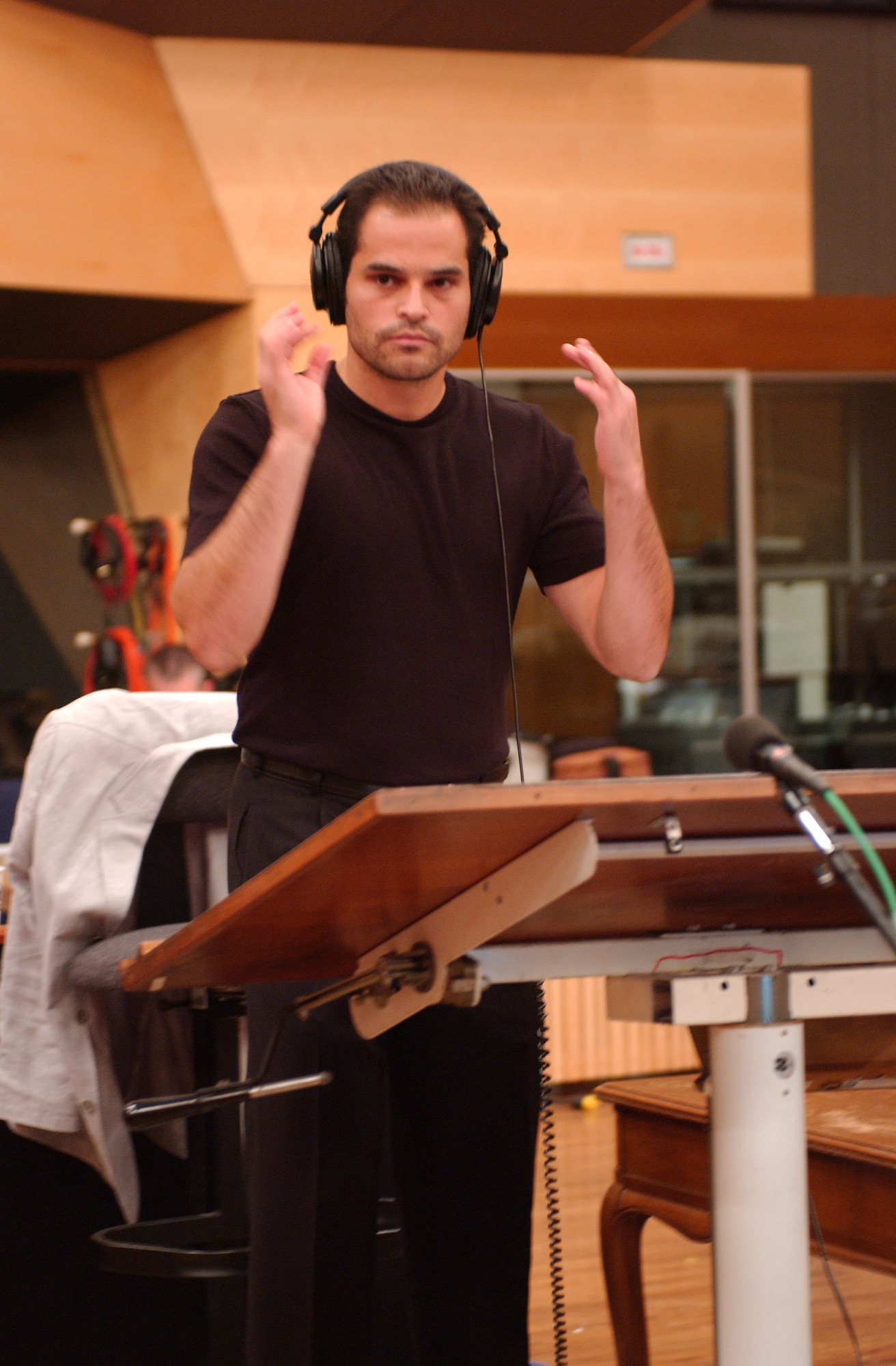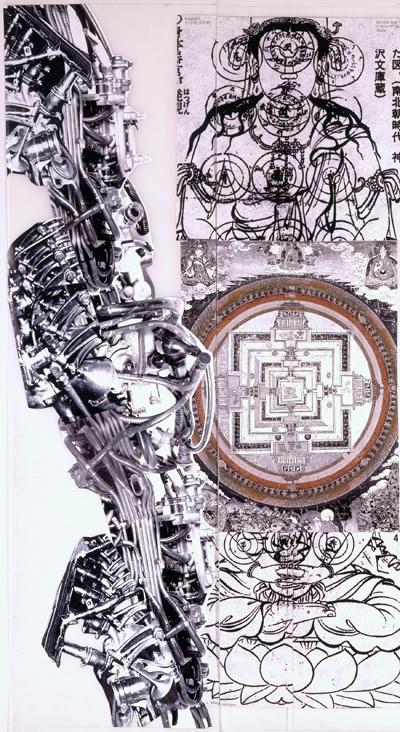|
By Donald H. Harrison
SAN DIEGO, Calif— Fathom, an inter-disciplinary production bringing
together the choreography of John Malashock, the art works of Junko Chodos, and
the music of Ariel Blumenthal—respectively born and raised in the United
States, Japan and Israel—is loosely a Buddhist story infused with some Jewish
ideas and forms.
In interacting with each other, two religious traditions and
three art forms create a Jewish-Buddhist artistic hybrid, a "Jew-Bu"
performance, that may well induce within audiences the feeling of being a baby reaching up in
delight from its crib towards a mobile. The baby hears the music, senses
the motion, apprehends the bright colors, and wants to get closer to the
wonderful object, yet is in no position to fully comprehend it.
That was the analogy that felt right to my 87-year-old father-in-law, Sam
Zeiden, and I on Saturday night, May 13, as we discussed the production while
driving home from the refurbished North Park Theatre where Fathom will
continue its run through May 21.
 Pursuing the analogy a day or so later with members of the artistic team,
I realized none of them fully comprehended their work—at least not in
its totality. Malashock pointed out "there are some ideas that can't be
expressed in words—that's why there is dance," and the same may be said
equally about music and the visual arts. If the wellsprings of one's own
work are ineffable, how much more difficult is it to fathom each other's
creative processes?
Pursuing the analogy a day or so later with members of the artistic team,
I realized none of them fully comprehended their work—at least not in
its totality. Malashock pointed out "there are some ideas that can't be
expressed in words—that's why there is dance," and the same may be said
equally about music and the visual arts. If the wellsprings of one's own
work are ineffable, how much more difficult is it to fathom each other's
creative processes?
And yet, by creating together, Chodos, Malashock and Blumenthal have
created a body of work—even as the parents of that baby lying in the crib, by
their coming together, created something new and beautiful. Of
course, the parents understood that the child was produced by procreation, but
sexual union was only the most basic part of their collaboration. Why did
they find each other attractive in the first place?
John Malashock
What chemical processes
governed their sexual response? What genetic processes were at work as the
child's gender and features were determined?
As many questions might be asked about the creations of not only Chodos,
Malashock and Blumenthal, but also of Junko's Jewish husband, Rafael, with
whom she has a collaboration within the collaboration; about each of the
seven dancers, especially Michel Mizerany who is on stage almost the entire
performance; the San Diego Master Chorale; and percussionist Steven
Schick.
 All stories have their origins somewhere, and, in this case, we can start with
Junko Chodos, who grew up in Japan and was familiar with the biography and
legends surrounding Kuukai, the founder of one form of Japanese Buddhism. Born
Saeki no Mao in 774, he was a bright student trained in the principles of
Confucianism. But feeling that he knew little about ultimate questions such as
man's purpose, he studied Buddhism. Early in his career, he sat at a place on
the island of Shikoku overlooking the sea and repeated a mantra one million
times in an effort to improve his spiritual memory. From that experience
he took the name Kuukai, which means "sky and sea."
All stories have their origins somewhere, and, in this case, we can start with
Junko Chodos, who grew up in Japan and was familiar with the biography and
legends surrounding Kuukai, the founder of one form of Japanese Buddhism. Born
Saeki no Mao in 774, he was a bright student trained in the principles of
Confucianism. But feeling that he knew little about ultimate questions such as
man's purpose, he studied Buddhism. Early in his career, he sat at a place on
the island of Shikoku overlooking the sea and repeated a mantra one million
times in an effort to improve his spiritual memory. From that experience
he took the name Kuukai, which means "sky and sea."
To learn more, he went to Chang'An, China, where he studied under Hui-Kuo, known as the 7th
abbot of Escoteric Buddhism. Although the master had 1,000 disciples, he
recognized in Kuukai the spiritual figure|
Junko Chodos
who would be his successor. After
only three months of study, Kuukai was ordained as the 8th abbot. He
returned to Japan with trunks laden with sacred scrolls, calligraphy and art,
and created Shingon (True Word) Buddhism that united both spiritual and
physical principles with particular emphasis on the saying of the Buddha that
"in this fathom-long body, the whole of the universe is
revealed." The religion also merged ideas contained in the indigenous
Shinto religion of Japan with those of Buddhism.
Kuukai opened schools that both the poor and the rich could attend, and created
a phonic system for writing the Japanese language, thereby extending literacy to
the common people. There are innumerable folk tales about Kuukai,
some of them similar to the tales Jews tell about Moses or that Christians tell
about Jesus. Kuukai is credited with bringing forth a spring, healing the
sick, giving sight to the blind, making the crippled walk, digging a well and
taming an unruly river among other miracles.
One can circumnavigate the island of Shikoka on a pilgrimage route that will
take you to 88 temples located in a variety of topographical zones, thereby
imitating the experiences of Kuukai as he came to understand the Buddhist
teaching that all
men and women have the seed of Buddhahood within them, and, therefore, are able
to achieve enlightenment by practicing the right precepts.
At the very first temple on the pilgrimage, visitors are reminded of what are
called the Ten Commandments of Buddhism, some of which are identical to, and
perhaps incorporated, commandments that western religions believe that Moses received at
Sinai. Among these are 1) Do not kill; 2) Do not steal; 3) Do not commit
adultery; 4) Do not tell a lie; 5) Do not use flowery language; 6) Do not speak
ill of others; 7) Do not be double tongued; 8) Do not be covetous; 9) Do not be
angry; 1)) Do not be perverse.
Some believe that Kuukai never died, that he resides on Mt. Koya, where is
fixed in a permanent state of meditation. After he left the realm of this
world in 835, Kuukai was given the honorific name Kobo Daishi.
In 2001, Chodos and Malashock were introduced. At the time, her series of
works, "Escoteric Buddhism: Sexual ecstasy, clean and pure, this too is the
realm of the Bodhisattva (State of Enlightenment)." The idea that the
entire universe is reflected in the body intrigued Malashock. Rafael
Chodos, Junko's Jewish husband, elaborated upon this idea, sharing these
thoughts with me in an e-mail exchange:
The Esoteric Buddhism which Kuukai studied in Chang'An was
a development from Tantric Buddhism, which celebrated the body and sexuality as
one of the great sources of energy which could move people towards
enlightenment. The sexuality which Tantric Buddhism celebrated was not
lustful or orgiastic: it was the sexual energy which comes from being
aligned with the energy of the Universe. The central teaching of Kuukai's new religion was an extension of this doctrine.
Kuukai's teaching that enlightenment could be achieved in this lifetime
carries with it the implication that the body is not an obstacle to
enlightenment, but is instead a vehicle.
How different from Kuukai's views are the dominant Western teachings about the
nature of the body. Pythagoras and the Orphics taught that the body is a tomb.
The notion persisted into Christian times that there is an opposition
between the body and the soul: that the soul is the higher aspect of the
complete person and the body is the lower aspect. The good life requires a
rejection of the demands of the body in order to respond to the demands of the
soul.
The Jewish idea is that the complete person is a body animated by a soul. After
God had created Adam out of the dust of the earth, He "breathed into his
nostrils the breath of life, and man became a living soul" [Genesis
2:7]. In Jewish thought, the soul needs the body in order to act:
by itself, the soul is incomplete. So Saadia Gaon, who lived a
century after Kuukai, taught that the good life can be achieved through prayer
(which he saw as the proper way towards the understanding of God) and good deeds
- but even this idea, though closer, is a world away from Kuukai's enthusiastic
embracing of the body as a necessary vehicle towards enlightenment.
Malashock said he and Junko Chodos decided that they would like to collaborate
together on a piece associated with the images of Kukkai and "that was when
I began to look at how to bring my own background and Jewish spirituality in as
well. I wasn't looking for Jewish content but I knew that it would find
its way in there. One trusts that one's background would go into the
work. It also was a conscious choice not to make things sound more Jewish,
but to chose a composer (Ariel Blumenthal) with whom I felt there would be a
good resonance between himself and myself in the Jewish realm."
 Blumenthal and Malashock had come to know each other through the Center for
Jewish Creativity and Culture founded by Ruth Rauch and the late John Rauch in
Los Angeles.
Blumenthal and Malashock had come to know each other through the Center for
Jewish Creativity and Culture founded by Ruth Rauch and the late John Rauch in
Los Angeles.
The collaborators decided not to make Fathom a biographical work, because
that would be too limiting, but rather one, in which the audience, through the
dancers, could experience "the body as universe" within a series of
scenes that evoked the life and legends of Kuukai.
The production is divided into two acts, with the printed program hinting at
what the dancers will try to communicate on stage. Act 1, Scene 1 is
"Sorcery" in which "ritual and ceremony brought to mundane
activities inspires awe and spirituality." We see Mizerany, as Kuukai,
commanding people to take the forms of animals—the choreography for which
Malashock said was inspired by three of Junko's mylar panels which hang
over the stage during this portion of
Ariel Blumenthal
the performance, each 3 1/2 feet wide and
10 feet deep. In our email exchange, Rafael Chodos, elaborated upon the scene:
Kuukai left the normal career track
(brilliant student who would be educated and then go into government service)
and went into the forest, where he lived the life of a sorcerer. There he
meditated, swung from tree to tree, ate rocks and minerals - in order to absorb
their powers. In Japanese culture, the mountain forests and streams are
places similar to what the desert is in Judaeo-Christian religious culture: a
place "away from the world", where one can be closer to the elemental
forces, or to God. -- The visual image is of a wild figure, almost
bird-like, who leaps into the midst of a mysterious forest. Kuukai's
life-path is very similar to that of the Old Testament prophets: he left
the world and communed directly with God, and when he was ready he returned to
the world and made a huge contribution to the society he had left before. This
notion of the prophet is similar.
Act 1, Scene 2 is entitled "Communicating with Nature," with the
program explaining "Magical powers are evoked from the integration of
nature and human behavior." Rafael Chodos describes it this way:
By now, Kuukai has grown and instead of
being merely a sorcerer, he is almost a priest. The visuals here are more lush
and less frightening: Kuukai is communicating with nature, not trying to
control it...We see a maturation of the relationship with nature away from a
hostile, manipulative one (magic) into a more loving one.
Here, one of the most specifically Jewish elements of the production enters the
score, as Blumenthal has the San Diego Master Chorale chant in Hebrew words from
Deuteronomy 20:19, "you shall not destroy its trees by swinging an axe
against them; for you may eat from them, and you shall not cut them down.
For is the tree of the field a man, that it should be besieged by
you." The biblical instructions are considered some of the
first ethical guidelines ever set forth for soldiers..
Act I, Scene III is "The Journey of the Spirit," described in the
program as a "perilous journey over turbulent seas to a new
world." This is said to parallel "the journey of spirit"
and to promote "an appreciation for the coexistence of diverse people—a
'universal' vision. Rafael Chodos explains:
Kuukai went on this journey in his late
20s. The visuals portray the perilous ocean, the shipwreck he experienced,
and then the ancient city of Chang'An - at the eastern end of the Silk Road, the
most cosmopolitan city in the whole world in the 9th Century, where all cultures
encountered each other. Kuukai lived for 2 years "al admat nechar",
on foreign land; but instead of weeping, he eagerly absorbed all the cultural
influences to which he was exposed and integrated them into his new religion.
In this way, he encapsulated what Judaism has done through the centuries:
existing in diaspora, it has absorbed the wisdom of the world outside and yet
preserved its own identity. Kuukai brought Esoteric Buddhism back to Nara
(the Japanese capital at that time) with him, but he integrated it with the
native Shinto - and this formed a new religion.
Following the intermission, Act II begins with the Tantric world, reprising the
title of Junko's exhibition: "Sexual ecstasy, clean and pure, this too is
the realm of Boddhisatva." The dancers, men and women, men and men,
women and women, seem to convey passion through the tension of their
restraint. Rafael Chodos suggests the comparison of
Genesis, and Saadya ( the body is essential to
spiritual life because the spirit needs the body to express itself in this
world) to Tantric ideas (the body is a vehicle towards enlightenment because it
enables us to vibrate in sympathy with universal sexual energy).
  Act II, Scene II, "Moving Mandala" invites the audience to
"transcend a world that cannot be controlled by thoughts through the unity
of the intellect and emotion." Here, too, we have a Jewish
infusion: Act II, Scene II, "Moving Mandala" invites the audience to
"transcend a world that cannot be controlled by thoughts through the unity
of the intellect and emotion." Here, too, we have a Jewish
infusion:
The visuals are intended to be pages
from a cosmic notebook, each page drawing our attention to some deep truth about
the way the universe is put together. You will recognize the kabbalistic
body charts showing the Sefirot, which are quite similar to the mandalas made in
India, Tibet, China, and Japan. This style of philosophical drawing seems
to have gained currency in the 7th Century and following, and Jewish thinkers
experimented with it as well. The fact is, Junko actually looked at
various Kabbalistic charts and made one of her mandalas "in that
image."
Kabbalah
sefirot
Mandala by Junko Chodos
Finally, there is Act II, Scene III "Eternal Meditation on the
Mountain," reinvoking the Kuukai legend. "At home in nature, the
spirit lives for eternity."
The visual shows the mountain with
lights - reflecting the ceremony Kuukai invented in which everyone lit a candle
and walked up the mountain with it, to show that rich and poor, great and low,
we all illuminate the world. The text Ariel used is actually from one of
Kuukai's poems, which comes from Buddhist ideas -- not Jewish ones. But
the symbolic value of light - oil lamps, candles -- this is very possibly
something Kuukai learned in Chang'An, because it was not Japanese. And it
probably comes at least indirectly from Judaeo-Christian sources, although I'm
not sure of that.
Discussing Junko's impact on him, Malashock told me: "The
imagery is so powerful. .. It is not as direct as the music, I can't choreograph
to the look of the art work, as I can to the sound of the rhythm, but
something like the nature section, with all the trees, suggested to me, humans
taking on animalistic form. It suggested the atmosphere."
With Blumenthal, the collaboration was more traditional. Used to
writing music for moods for television productions, Blumenthal took Malashock's
thoughts about what he wanted to convey, then wrote music to suit. In some
cases, Malashock was quite specific, even to the length of time that he wanted a
certain segment to run, in other cases, he gave Blumenthal more free rein.
In preparing for the production, Malashock said that he visited the island of
Shikoka, which he found to be a spiritual place stirring in him feelings similar
to those he had experienced in Sfad, home of mystical Judaism. In creating the
music, however, Blumenthal said he did not attempt to illustrate mysticism with
the klezmer sounds that Sfat has embraced in recent years. Instead, he
said, he tried to express an idea with musical instruments that was parallel to
what Malashock was attempting to do with the human body—to show that
instruments themselves can contain a universe, indeed, that they can sound very
human.
Blumenthal is familiar with many realms of music, including classical. Rabin,
his tribute to the slain Israeli prime minister, has been played by numerous
orchestras, including recently by David
Amos and the Tifereth Israel Community Orchestra. But for Fathom, Blumenthal
turned to the digital synthesizer in an effort to show how various sounds could
be manipulated—even as the folk figure of Kuukai, on stage, could manipulate
the other dancers.
Rafael Chodos said that as a student in Japan, his wife was very
influenced by Martin Buber;s concepts of "I and Thou," as well as by
kabalistic teachings.
|

